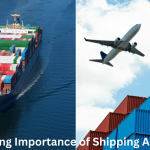Shipping is an essential component of modern commerce, especially in the digital age, where online shopping and e-commerce are booming. Whether you’re a small business owner, an e-commerce retailer, or a consumer, understanding the shipping process and how to simplify it can significantly impact your success. Complex logistics, rising costs, and customer expectations for fast, affordable deliveries have made shipping one of the biggest challenges in today’s retail landscape. However, by focusing on key strategies and leveraging technology, shipping can be made simpler and more efficient.
This article will explore how businesses can simplify shipping processes, cut down costs, and ensure customer satisfaction, all while staying competitive in the evolving shipping landscape.
Understanding the Basics of Shipping
Shipping involves the transportation of goods from one location to another. It covers everything from inventory management to package labeling, from selecting the right carrier to tracking deliveries. Although the process may seem simple on the surface, many businesses find themselves overwhelmed by the logistics involved, especially when shipping large volumes or international orders.
For businesses of all sizes, simplifying shipping means optimizing processes to ensure fast, cost-effective deliveries. It also means choosing reliable shipping carriers and having a seamless system for handling orders, packaging, and customer communication.
Key Elements of a Simple Shipping Process
Several factors contribute to making shipping simple. These include having a clear understanding of shipping carriers, packaging requirements, international shipping regulations, tracking systems, and delivery time expectations. Here’s a breakdown of the key elements that can simplify your shipping operations:
- Choosing the Right Shipping Carrier One of the most important decisions businesses must make is selecting the appropriate carrier. In the U.S., major shipping carriers include USPS, UPS, FedEx, and DHL. Each carrier offers various shipping options that differ in cost, speed, and services provided. The right choice depends on several factors:
- Destination: Some carriers are better suited for international shipping, while others specialize in domestic deliveries.
- Speed: For time-sensitive shipments, carriers like FedEx and UPS offer expedited services, whereas USPS provides more affordable, slower options.
- Cost: Shipping rates can vary significantly, depending on package size, weight, and distance traveled.
It’s essential to compare rates and services from different carriers to find the best option for your specific needs.
- Packaging and Labeling Proper packaging is crucial for protecting your products during transit, while also ensuring that packages are cost-effective to ship. Lightweight yet sturdy packaging can help minimize shipping costs, especially when carriers charge based on size and weight. Additionally, using appropriate labeling with accurate addresses, barcodes, and tracking information helps prevent delays and lost packages.
- Tracking and Transparency Modern shipping methods allow both businesses and customers to track shipments in real time. This transparency is crucial for managing expectations and ensuring customer satisfaction. Many shipping carriers offer built-in tracking solutions that provide customers with status updates via email or SMS. For businesses, integrating tracking software with e-commerce platforms or point-of-sale (POS) systems can help automate this process, making it easier to monitor shipments and resolve issues proactively.
- International Shipping Simplified Shipping internationally can be daunting, given the additional complexities of customs, duties, and import/export regulations. However, understanding and simplifying the international shipping process is essential for businesses looking to expand globally. Here’s how to make it simpler:
- Partner with an experienced carrier: Some shipping carriers specialize in international shipments and handle the customs process for you.
- Clear documentation: Ensure that all necessary paperwork (e.g., commercial invoices, packing lists, certificates of origin) is completed accurately.
- Know the taxes and duties: Calculate any taxes or import duties in advance and clearly communicate these costs to customers to avoid unpleasant surprises.
- Automation and Technology One of the most effective ways to simplify shipping is by automating repetitive tasks such as order processing, shipping label generation, and tracking updates. Shipping software like ShipStation, Shippo, or Easyship integrates with major e-commerce platforms (like Shopify, WooCommerce, and Amazon) to streamline these tasks. These tools can automatically select the best shipping carrier based on cost and delivery time, print shipping labels in bulk, and send tracking updates to customers. Automation reduces manual errors, saves time, and helps businesses stay organized, especially when managing high volumes of shipments.
- Offering Free or Discounted Shipping In today’s competitive marketplace, offering free or discounted shipping can be a major selling point for businesses. However, it’s important to do so without eating into profits. Businesses can simplify their shipping strategy by adopting one of the following models:
- Free shipping with minimum spend: Encourage customers to spend more by offering free shipping for orders that exceed a certain amount.
- Flat-rate shipping: Charge a fixed shipping rate regardless of package weight or destination to simplify pricing.
- Built-in shipping costs: Factor shipping costs into product pricing, allowing businesses to advertise “free” shipping without losing money.
Implementing one of these strategies can make shipping more straightforward for both businesses and customers, reducing friction during the checkout process.
Common Shipping Challenges and How to Overcome Them
Despite efforts to streamline shipping, businesses often face challenges that complicate the process. Below are some of the most common shipping hurdles and tips for overcoming them:
- High Shipping Costs Shipping costs can eat into profit margins, particularly for small businesses or those offering free shipping. To mitigate this, businesses can:
- Negotiate with carriers: Shipping carriers may offer discounts to businesses that ship high volumes.
- Use packaging efficiently: Use appropriately sized packaging to reduce dimensional weight costs.
- Optimize shipping zones: Set up distribution centers closer to key markets to reduce shipping distance and costs.
- Lost or Delayed Shipments Lost or delayed shipments can harm customer relationships and lead to costly refunds. To address this issue:
- Use reliable carriers: Partner with carriers that have a reputation for timely and safe deliveries.
- Offer shipment insurance: Consider adding insurance for high-value items to cover losses or damages during transit.
- Provide tracking information: Keep customers informed with real-time tracking updates to manage their expectations.
- Managing Returns Returns are a natural part of the online shopping process but can be a logistical headache. To simplify returns:
- Create a clear returns policy: Make it easy for customers to understand how and when they can return products.
- Offer prepaid return labels: Provide prepaid return labels to encourage hassle-free returns, which can boost customer confidence and loyalty.
Final Thoughts: Simplifying Shipping for Business Success
Shipping is a vital part of any retail operation, and simplifying the process can lead to happier customers, reduced costs, and improved efficiency. By choosing the right carriers, leveraging automation, offering transparent tracking, and optimizing packaging, businesses can streamline their shipping processes. Ultimately, making shipping simple benefits both businesses and consumers by ensuring that products are delivered quickly, affordably, and reliably.
As e-commerce continues to grow, businesses that master the art of simple shipping will be well-positioned to thrive in an increasingly competitive marketplace.
FAQs
1. What is dimensional weight, and how does it affect shipping costs?
Dimensional (DIM) weight is a pricing technique used by shipping carriers that accounts for a package’s size in addition to its weight. Larger but lighter packages are charged based on their dimensions rather than their actual weight. To minimize costs, use appropriately sized packaging to reduce the dimensional weight pricing.
2. How does shipping tracking work, and why is it important?
Shipping tracking allows both businesses and customers to monitor the real-time status of a package throughout its journey. This transparency helps manage customer expectations and reduces inquiries about delivery status. Most shipping carriers offer tracking services, and many e-commerce platforms automatically integrate these updates into customer accounts or emails.
3. What is the difference between domestic and international shipping?
Domestic shipping refers to deliveries within a single country, while international shipping involves sending goods across national borders. International shipping typically requires additional documentation, such as customs forms and commercial invoices, and may incur taxes, duties, and import fees. Delivery times and costs are usually higher for international shipping compared to domestic shipping.
4. What is last-mile delivery, and why is it important?
Last-mile delivery refers to the final stage of the shipping process when a package is delivered to the customer’s doorstep. It is one of the most challenging and costly parts of the shipping process due to factors such as traffic congestion, remote locations, and handling individual packages. Last-mile delivery plays a crucial role in customer satisfaction and on-time delivery performance.
5. What role does customer communication play in simplifying shipping?
Keeping customers informed throughout the shipping process is crucial for managing expectations and maintaining satisfaction. Sending automated notifications for order confirmations, shipment tracking, and estimated delivery times can reduce customer inquiries and improve trust.




